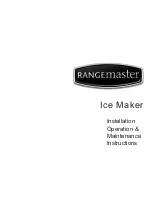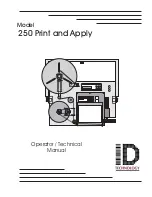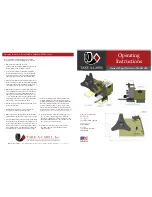
LABEL CONVERTING SPECIFICATIONS
In order to insure the labeling machines function, the following label specifications are offered as part of this proposal.
Seller recommends that Buyer include a copy of these specifications with Buyer’s purchase order for labels from
Buyer’s label converter. There may be exceptions to these specifications, depending upon the particular label
construction used.
Labels shall be converted with 3 mm + .13 mm minimum spacing between labels, and a minimum side gap of 1.5
mm + .15 mm slit on each side of the label. Maximum media width is determined as appropriate for the print
engine selected. Labels shall not be converted with perforations of other separations between labels.
A standard minimum 76 mm ID core is recommended [101 mm or 152 mm ID cores may also be acceptable].
Standard maximum roll OD shall be 305 mm [rolls up to 406 mm may also be acceptable]. Cores shall be slit
cleanly to the final media width, including tolerance, and shall be of such composition so as to resist crushing
distortion. The roll end shall not be attached to the core with tape or adhesive.
Labels shall be wound to the outside of the roll unless otherwise specified. The labels shall be cleanly die cut,
waste removed with no nicks or marks to the outside label perimeter, and centered on the backing media. If
possible [unless otherwise specified] the labels shall be oriented: (1) to feed the trailing edge perpendicular to the
backing media edge; and, (2) to feed the label with its shortest dimension parallel to the feed path.
There shall be no strike-through or fractures of the backing media by the label processing die which can be
detected by ink or marker penetration after wiping. There shall be no tears or cuts on the backing media edges.
The backing media shall be of a uniform density and thickness. It shall be sufficiently translucent as to assure
reliable gap detection, given the label stock selected.
All eye marks or sensing notches shall be located with the same tolerance as specified for the labels and located on
the backing media as is appropriate for the print engine selected. Eye marks shall be opaque, of a uniform
density, and a minimum of 6 mm in width by 3 mm in the feed direction. Sensing notches, if possible, shall be as
small as practical and located away from the edge of the backing media.
The label rolls shall not be wound so tightly as to cause the adhesive to bleed out from around the label edges nor
so loosely as to cause roll telescoping. The labels shall be wound with consistent wind tension and shall be flat
within 3 mm when measured from a reference surface.
Where splicing is necessary in the label roll, splicing shall be consistent with the requirement of the automatic
labeling machinery. Preferred splices, when required, shall be of a diagonal style, using a clear transparent pressure
sensitive tape applied to the back side of the backing web only (non-release coated side). All factory splices shall
be removed, unless they meet the preferred splice specification.
All finished label rolls shall be appropriately marked for identification per customer requirements and shall be
packed to assure that the rolls arrive clean, flat and without shipping damage.
The label adhesive shall be tested thoroughly to insure the compatibility of the label to the Buyer’s product and to
have the proper amount of permanence or removability according to Buyer’s specifications. All face stock and
adhesive combinations are subject to testing for dispensability on automatic labelers prior to acceptance.
Summary of Contents for LITTLE DAVID LX600
Page 8: ...Safety Decal Locations...
Page 9: ...Safety Decal Part Number...
Page 14: ...Refer to Section 2 Threading the Label Stock...
Page 23: ......
Page 55: ...MAIN FRAME AND STAND ASSEMBLIES FOR ALL MODELS...
Page 73: ...PNEUMATIC ASSEMBLIES FOR ALL MODELS...
Page 77: ...PNEUMATIC DIAGRAM STRAIGHT TAMP MODELS...
Page 78: ......
Page 79: ...PNEUMATIC DIAGRAM DUAL TAMP SWING ARM MODEL...
Page 80: ......
Page 81: ...APPLICATOR ASSEMBLIES STRAIGHT TAMP MODELS...
Page 84: ...APPLICATOR ASSEMBLY DUAL TAMP SWING ARM MODEL...
Page 86: ...ELECTRICAL ASSEMBLY AND SCHEMATICS FOR STRAIGHT TAMP And DUAL TAMP SWING ARM MODELS...
Page 87: ......
Page 88: ......
Page 89: ......
Page 90: ......
















































